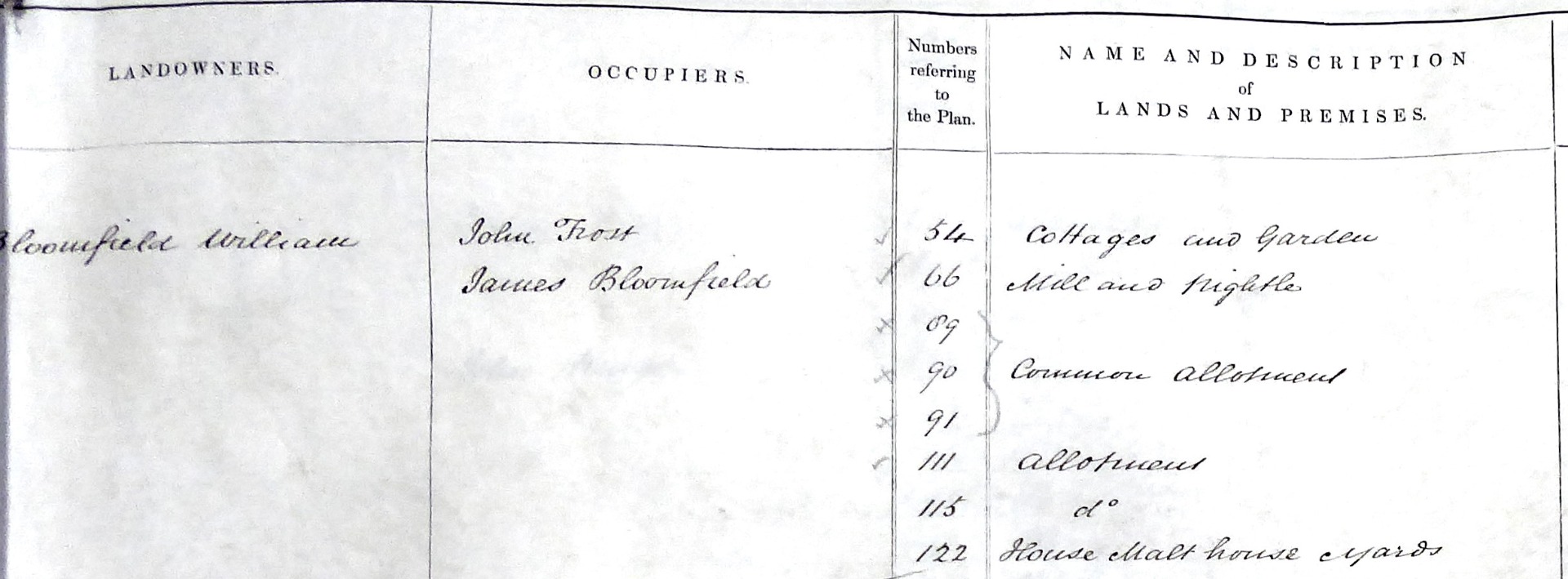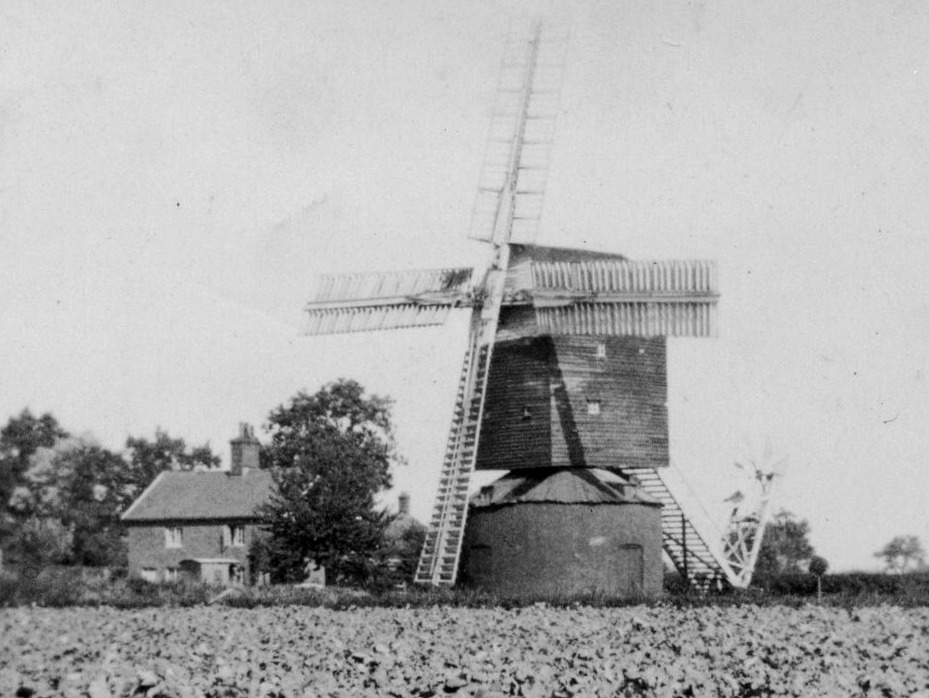The Black Mill
The Black Mill (also known as Spratt's Mill)
The Black Mill was a post mill with a brick round house that
stood on the turnpike in Forncett End, diagonally across from the Jolly Farmers
pub and the White Mill, from around 1805 until 1932 when it was demolished. The
mill was owned by two families, the Blomfields and the Spratts, for most of its
working life.

The Black Mill in 1927 - photo, Frank Gregory

Faden's map - 1790
The first mill, sometimes referred to as Tacolneston South Mill, was just within Tacolneston parish, between New Road and Common Road. The second was Tacolneston East Mill, which stood about 1km away, near the junction of New Road and Storeys Lane. In 1779 this mill was owned by James Blomfield, a miller and baker who lived in Tacolneston. The third mill was known as Tacolneston Mill and in 1764 it stood at the northern-most edge of Forncett Common together with a dwelling house and other buildings.

So, did one of the three mills on Faden's map become the Black Mill ?
When Maltings Farm was sold in 1783 the sale also included "a windmill with a cottage and an acre of land" which appears to be the mill owned by John Durrant in 1764. Furthermore, when Maltings Farm was put up for sale again in May 1786 the property included a post mill that had been "rebuilt within twelve months".

Norfolk Chronicle - 13 May 1786
When the Black Mill was demolished in 1932, under the guidance of mill enthusiast Harry Clark, he recorded that the framing of the mill was definitely constructed in 1785 (East Anglian Daily Times, 17th September 1932). This strongly links the post mill at the far end of Forncett Common to the Black Mill and suggests that when it was rebuilt by the owner of Maltings Farm it stayed in the same location, because it is shown there on Faden's map of 1790-1794.
Maltings Farm appeared in another sale advertisement in 1787 but without the mill, suggesting that the mill was sold in the sale of 1786. The likely purchaser was miller and baker, James Blomfield (1739-1820) from Tacolneston, who was the mill's owner on the 1813 map of Forncett. In that case, around 1797 Blomfield would have owned two mills – Tacolneston Mill at the far end of Forncett Common, and Tacolneston East Mill on New Road.
In 1932 Harry Clark also stated that "the date 1805 on a stone over the door represents the building of the brick round house which was an afterthought". Clarke also noted that "Carvings state that one miller came from Marlingford in 1806. Another beam carries a list of six names carved in the woodwork which may be the gang of millwrights who constructed the mill. The great post itself weighing between three and four tons is now known to have been grown in a field adjoining the present site."
Given that the Black Mill was apparently moved sometime between 1786, when it was still at the far end of Forncett Common, and 1813, when it was in its final location on the Turnpike, it seems very likely that it was moved in 1805. Furthermore, given that there is no further record of Tacolneston East Mill, James Blomfield may indeed have used parts from both his mills to construct the final Black Mill.

1817 map of Forncett showing the Black Mill (Norfolk Record Office)
Although James Blomfield owned Maltings Farm in Forncett End, it was probably the home of his son William (1775-1850). William and his family lived in Forncett from his marriage, in 1796, to sometime around 1830 when he moved to Necton, near Swaffham and the mill was taken over by his son, James Blomfield jnr. (b.1797). So, in 1839 the tithe records show that the mill was still owned by William Blomfield but was being run by his son James who was living at Maltings Farm.

1839 Tithe record for the Black Mill and Maltings Farm - Norfolk Record Office
In the 1841 census Maltings Farm was occupied by James Blomfield, his wife Sarah and daughter Hannah. They had three servants, and also present were Isaac Hunt (25) journeyman miller, William Collins (25) journeyman miller, and Charles Leighton (19) apprentice miller. So, the mill was a very active enterprise.
Then in August 1849 the Blomfield family suffered a serious loss as James Blomfield jnr died of rheumatic fever at the relatively young age of 52. Less than a year later, his father William died, aged 75. Both are buried in St. Peter's churchyard in Forncett.

Norfolk Chronicle - 5th January 1850
The mill was taken over by James' son, also called James Blomfield (1820-1890)! So, the 1851 census shows James Blomfield (age 30), miller and maltster, running the mill and employing four men. His widowed mother, Sarah Blomfield, was still living in Forncett End (probably at Maltings Farm), farming 300 acres and employing 12 men. In August 1851 James married Anne Gardiner (age 21) from Hethel and two years later, in July 1853, William Blomfield's estate, including the Black Mill, was finally put up for sale at auction.

Sale Document for the Black Mill - 23rd July 1853 (courtesy of Philip Yull)
White's directory shows that James was still running the Black Mill in 1854 but by 1855 he had left Forncett to run the water-powered Chimney Mill in the village of Culford, in Suffolk near Bury St Edmunds.
After James Blomfield left Norfolk, the Black Mill appears to have stayed in the family and it was probably overseen either by his uncle, Miles Blomfield, who was the miller at Keswick watermill or his brother, Dennis, who became a miller at Mulbarton.
The 1858 Post Office directory lists a Robert Greenacre (maltster and miller) in Forncett who was probably running the Black Mill. However, by the 1861 census Greenacre had left and William Youngs (Miller, age 70) and George Butler (Journeyman Miller, age 28) were probably running the mill. William Youngs was a widower and previously the miller at Ashby St. Mary near Loddon (1851 census). He was the brother-in-law of John Stimpson, who was a shopkeeper in Forncett.
Just two years later Harrod's directory of 1863 records James Spratt, farmer and miller in Forncett. James Spratt came from a family of millers. His father, John Spratt, had been a miller in Hapton and in Burgh next Aylsham and other members of the Spratt family had been millers in Mulbarton, Shotesham and Saxlingham. James was born in Burgh but moved to Tacolneston as young man and by 1861 (age 45) he was a farmer of 65 acres in Tacolneston. However, it appears that soon afterwards he became a tenant farmer and miller for the Blomfields and moved to Maltings Farm in Forncett.
The Black Mill was again put up for sale in 1864 but it was just one lot in a much larger sale, suggesting that Sarah Blomfield had decided to sell all her properties. Sarah died in January 1870 and was buried in Forncett.

Norfolk Chronicle - 10th September 1864
In 1867 the Black Mill and its land were conveyed to James Spratt by Miles Blomfield and in the 1871 census the mill was being run by Spratt's son, James Spratt jnr. (age 26). Ten years later, in 1881, another son, Dennis Spratt (age 19) was the miller. By 1891 James Spratt snr. was 74 years old, so although he is listed as "miller" in the census, the mill was probably being run by one of his sons, Henry, Alfred or Dennis, all of whom were still living on the farm.
James Spratt died in 1895 (age 78) and then in 1899 the mill was once more put up for sale, as part of a larger sale of a number of properties.

Norfolk Chronicle - 10th June 1899
The mill was sold to Mr. G. Blake for £260 but it may well subsequently have been run by James Spratt jnr. who, in 1901, was living in Forncett End, near Fox's Stores, and described himself as "Miller and Stone Dresser". By 1911 his wife Elizabeth had died, but James (age 66) was still a Miller's Assistant, suggesting that he was still working at the Black Mill. James Spratt jnr. died, aged 80, in 1926.
Harry Clark reported that the mill ceased working during WWI but in her book "The King of the Barbareens" Janet Hitchman said that it was still working around 1925.
"Every afternoon I had to plod through the mud to a farm at Forncett End for the milk. At the end of the lane was a windmill, at that time still working."
The mill was sketched by Stanley Freese on 27 June 1929 (see below). Freese cycled extensively throughout England sketching and photographing mills. Some of these journeys were described by him in his chapters of "In search of English windmills" (Cecil Palmer, 1931), which he wrote with R. Thurston Hopkins. With regard to the Black Mill, he wrote "One of two old mills survives at Forncett End, a decrepit old postmill, with new sails & fantail, much too heavy for it ..."

Fortunately, the mill was photographed extensively by Hallam Ashley in 1931 and 1932 (see slideshow below). Ashley was a freelance photographer and a meeting with mill expert Rex Wailes in 1926 was the beginning of both a lifelong friendship and a lifelong love of wind, water and steam mills. In 1929 Hallam settled in Norwich, where he lived for the rest of his life.
In 1932 the mill was bought by Harry Clark who wrote in the EDP on 22 September 1932: "I bought this mill on behalf of a friend for a definite purpose. Certain parts are very good and I decided to carefully dismantle the mill, saving as many of the parts as possible with the sole object of repairing mills in other parts which otherwise would be allowed to pass into decay. This careful dismantling has been a sore trial to Harry Pointer's demolition gang, who in the ordinary way would have collapsed the structure in no time."
When the mill was dismantled, Rex Wailes presented 2 sails and a sound stock to Outwood Mill in Surrey and the other 2 sails to Herne Mill in Kent. Some remains of the mill were apparently still visible in 1946. The site was later owned by the Burroughes family who ran their shop there from 1964 to 2001. It was then redeveloped for housing as "Old Mill Gardens" in 2016.

One tangible reminder of
the mill does however still remain. The pair of cottages which stood at the end
of Dirty Road (now Bentley Road), and which can be seen on a number of
photographs of the mill, are still there. They were probably built in the late
1860s but, although now called "Mill Cottages", there's no evidence that they were
ever used as accommodation for the miller. The same two families, those of John
Briggs (labourer) and John Took (carpenter) lived there from at least 1871 until
the sale of the mill in 1899. In 1901 Briggs was still there and the other
cottage was occupied by Albert Humphreys (bricklayer).

